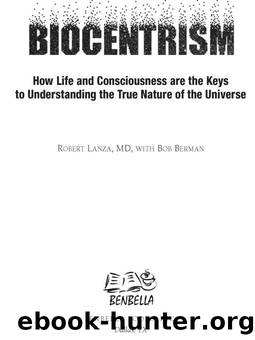Biocentrism by Bob Berman

Author:Bob Berman
Language: eng
Format: epub
Publisher: BenBella Books, Inc.
Published: 2010-05-31T16:00:00+00:00
11
SPACE OUT
Ye Gods! Annihilate but space and time, And make two lovers happy.
—Alexander Pope (1728)
How do our animal minds apprehend the world?
We’ve all been taught that time and space exist, and their apparent reality is reinforced every day of our lives—every time we go from here to there, every time we reach for something. Most of us live without thinking abstractly about space. Like time, it’s such an integral part of our lives that its examination is as unnatural as scrutinizing walking or breathing.
“Obviously space exists,” we might answer, “because we live in it. We move through it, drive through it, build in it. Miles, kilometers, cubic feet, linear meters—all are units we use to measure it.” Humans schedule meetings at places like Broadway and Eighty-second on the second floor of Barnes & Noble in the café. We speak in clear terms of spatial dimensions, often associated with times. It’s the “when, what, where” of daily life.
A theory of time and space as belonging strictly to animal-sense perception, as our source of comprehension and consciousness, is a new and perhaps abstract thing to grasp, and day-to-day experience has indicated nothing of this reality to us. Rather, life has seemingly taught that time and space are external—and perhaps eternal—realities. They appear to encompass and bind all experiences, and are fundamental rather than secondary to life. They seem to lie above and beyond human experience, the gridwork within which all adventures unfold.
As animals, we are organized and wired to use places and time to specify our experiences to ourselves and to others. History defines the past by placing people and events in time and space. Scientific theories such as the Big Bang, the deep time of geology, and evolution are steeped in their logic. Our physical experiences—of moving from point A to point B, of parallel parking, standing on the edge of a precipice—confirm the existence of space.
When we reach for a glass of water on the coffee table, our sense of space is usually impeccable. The glass almost never spills due to a miscalculated reach. To place ourselves as the creator of time and space, not as the subject of it, goes against common sense, life experience, and education. It takes a radical shift of perspective for any of us to intuit that space and time belong solely to animal-sense perception, because the implications are so startling.
Yet we all instinctively know that space and time are not things—the kind of objects that we can see, feel, taste, touch, or smell. There is a peculiar intangibility about them. We cannot pick them up and put them on a shelf, like shells or stones found at the shore. A physicist cannot bring back space or time to the laboratory in a vial, like an entomologist collects insects to be examined and classified. There is something oddly different about them. And that is because space and time are neither physical nor fundamentally real. They are conceptual, which means that space and time are of a uniquely subjective nature.
Download
This site does not store any files on its server. We only index and link to content provided by other sites. Please contact the content providers to delete copyright contents if any and email us, we'll remove relevant links or contents immediately.
| Aeronautics & Astronautics | Astronomy |
| Astrophysics & Space Science | Comets, Meteors & Asteroids |
| Cosmology | Mars |
| Solar System | Star-Gazing |
| Telescopes | UFOs |
Turbulence by E. J. Noyes(7039)
Tools of Titans by Timothy Ferriss(6947)
Astrophysics for People in a Hurry by Neil DeGrasse Tyson(4620)
Room 212 by Kate Stewart(4107)
Pale Blue Dot by Carl Sagan(4001)
The David Icke Guide to the Global Conspiracy (and how to end it) by David Icke(3882)
Secrets of Antigravity Propulsion: Tesla, UFOs, and Classified Aerospace Technology by Ph.D. Paul A. Laviolette(3450)
Apollo 8 by Jeffrey Kluger(3200)
Losing the Nobel Prize by Brian Keating(3187)
A Journey Through Divination and Astronomy by Publishing Pottermore(3070)
Goodbye Paradise(2963)
COSMOS by Carl Sagan(2950)
Brief Answers to the Big Questions by Stephen Hawking(2878)
How to Read Water: Clues and Patterns from Puddles to the Sea (Natural Navigation) by Tristan Gooley(2855)
The Five People You Meet in Heaven by Mitch Albom(2843)
The Order of Time by Carlo Rovelli(2714)
How to Read Nature by Tristan Gooley(2665)
A Brief History of Time by Stephen Hawking(2473)
Aliens by Jim Al-Khalili(2382)
